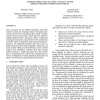Free Online Productivity Tools
i2Speak
i2Symbol
i2OCR
iTex2Img
iWeb2Print
iWeb2Shot
i2Type
iPdf2Split
iPdf2Merge
i2Bopomofo
i2Arabic
i2Style
i2Image
i2PDF
iLatex2Rtf
Sci2ools
WSC
2004
2004
Assessing Obstacle Location Accuracy in the Remus Unmanned Underwater Vehicle
Navy personnel use the REMUS unmanned underwater vehicle to search for submerged objects. Navigation inaccuracies lead to errors in predicting the location of objects and thus increase post-mission search times for explosive ordnance disposal teams. This paper explores components of navigation inaccuracy using discrete event simulation to model the vehicle's navigation system and operational performance. The simulation generates data used, in turn, to build statistical models of the probability of detection, the mean location offset given that detection occurs, and the location error distribution. Together, these three models enable operators to explore the impact of various inputs prior to programming the vehicle, thus allowing them to choose combinations of vehicle parameters that reduce the offset error between the reported and actual locations.
Explosive Ordnance Disposal | Modeling And Simulation | Unmanned Underwater Vehicle | Vehicle's Navigation | WSC 2004 |
| Added | 31 Oct 2010 |
| Updated | 31 Oct 2010 |
| Type | Conference |
| Year | 2004 |
| Where | WSC |
| Authors | Timothy E. Allen, Arnold H. Buss, Susan M. Sanchez |
Comments (0)

